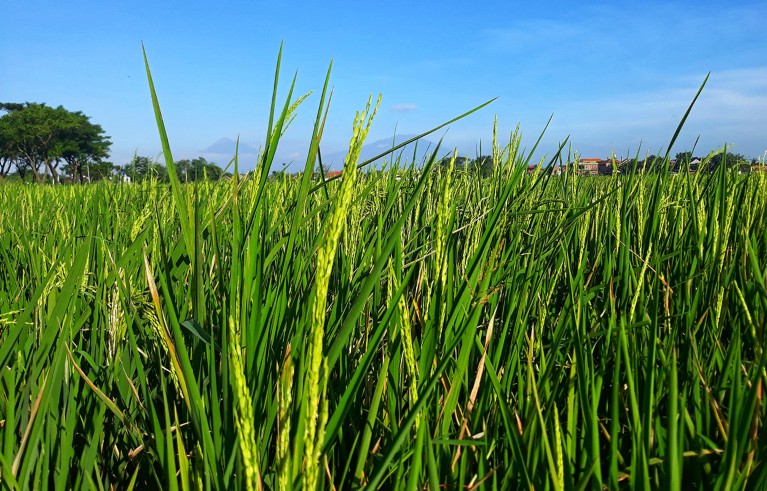
Asian rice plants inherited a tolerance for cold in just three generations.Credit: Adhi Syailendra/Getty
Rice plants can inherit tolerance to cold without changes to their genomes, according to a decade-long study1 carried out by researchers in China. The work, published in Cell today, strengthens the evidence for a form of evolution in which environmental pressures induce heritable changes that do not alter an organism’s DNA.
The study conducted experiments that demonstrate, for the first time, the mechanism for these changes — ‘epigenetic’ tweaks to chemical markers on the plant’s DNA that don’t actually tinker with the sequences themselves.
“What they’re showing is extremely convincing; I would say that it’s a landmark in the field,” says Leandro Quadrana, a plant geneticist at the French National Centre for Scientific Research in Paris-Saclay.
Michael Skinner, who studies epigenetic inheritance at Washington State University in Pullman, says the study adds to the growing body of evidence challenging the prevailing view of evolution that the only way that adaptations emerge is through gradual natural selection of randomly arising DNA mutations.
This study shows that the environment isn’t just a passive actor in evolution, but a selective force inducing a targeted change. “This is a very well done, very nice study, and it is easily understood,” says Skinner.
Chill time
Rice plants originated from tropical regions but can now be grown worldwide, even adapting to colder environments. Shanjie Tang, a plant geneticist at the Institute of Genetics and Developmental Biology, Chinese Academy of Sciences, in Beijing and his colleagues wanted to investigate how the plants acquired this ability to adapt to cold temperatures.
They identified an Asian rice (Oryza sativa L.) variety that was particularly susceptible to cold, producing fewer viable seeds when grown in colder environments. Just as the plants were readying to begin reproduction, the researchers placed them in a chamber set to –15 °C for 7 days, before returning them to a natural setting. Seeds were collected from plants that produced the most seeds, and this next generation was subjected to the same cold stress. The researchers noticed that, by the third generation, one variety produced many seeds, despite the cold stress. The plants maintained this ability for the five generations that the researchers continued the experiment.
Tang was surprised to see how quickly the plants developed this cold tolerance, a process that seemed to occur at a must faster rate than would have been expected from adaptation through natural selection. Although the finding took four years of growing and planting, and many more years of confirming the stability of the changes, “it’s quite impressive”, says Quadrana.
To rule out the possibility that this adaptation was due to a difference in the DNA sequence of the cold-tolerant plants, the researchers sequenced the genomes of these plants as well as of those that had not been chilled and had not developed the same tolerance. They found no genetic differences that could have contributed to the plants’ cold tolerance.
The biggest challenge, says Tang, was convincing reviewers that there were no genetic changes driving this adaptation, which is why they had to conduct extensive genetic tests to rule that possibility out.
The researchers then looked for ‘epigenetic’ markers, small molecules that can regulate gene activity, that differed between the two plant varieties. They found that, compared with the non-cold-tolerant plants, the cold-tolerant ones had fewer chemical tags added to the genome at the start of a specific gene, which they named Acquired Cold Tolerance 1 (ACT1). When they deactivated these chemical tags in the plants grown under normal conditions, they could tolerate cold stress better. And when the researchers edited them back in, the plants no longer had this ability. “This is demonstrating causality directly. That’s a first,” says Quadrana.
.png)



